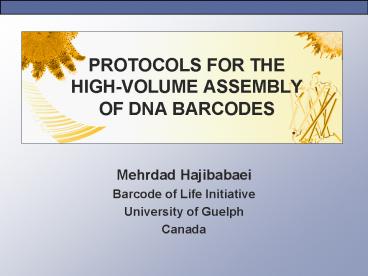PROTOCOLS FOR THE HIGHVOLUME ASSEMBLY OF DNA BARCODES - PowerPoint PPT Presentation
1 / 39
Title:
PROTOCOLS FOR THE HIGHVOLUME ASSEMBLY OF DNA BARCODES
Description:
How do we increase production rates, lower costs and speed analysis? ... Nataly Ivanova. Angela Hollis. Stephanie Kirk. John Burns. Jean-Francois Landry. Paul Hebert ... – PowerPoint PPT presentation
Number of Views:31
Avg rating:3.0/5.0
Title: PROTOCOLS FOR THE HIGHVOLUME ASSEMBLY OF DNA BARCODES
1
PROTOCOLS FOR THEHIGH-VOLUME ASSEMBLYOF DNA
BARCODES
- Mehrdad Hajibabaei
- Barcode of Life Initiative
- University of Guelph
- Canada
2
Barcoding Animals
Gaining Barcode Closure for Animals
10 million species x 10 barcodes each 100
million barcodes
3
Barcoding Animals
Barcodes in Perspective
100 million barcodes 65 billion base pairs
4
Barcoding Animals
The Time Frame
200 x 50K sequences per year
10 years to completion
5
Barcoding Animals
Logistical Challenges
How do we increase production rates, lower costs
and speed analysis?
How do we recover barcodes from archival
specimens?
6
The Barcoding Process
The Analytical Chain
Specimen or Tissue Sample
DNA Barcode
PCR COI
Sequence COI
Extract DNA
7
The Barcoding Process
Model 1 Core Facility
Core Facility 50-100K Barcodes/Year 1M
Core Facility receives specimen samples
8
The Barcoding Process
Model 2 Satellite Labs
Sequencing Facility 800K
Sequencing Facility receives PCR product
9
The Barcoding Process
The Guelph Analytical Node
Sourcing Specimens
Extracting DNA
Guelph Analytical Node
DNA Amplification
Screening PCR Products
Sequencing
Barcode of Life Database
10
Sourcing Specimens
Sourcing Specimens
11
Sourcing Specimens
Specimen Submission Package
12
DNA Extraction
DNA Extraction
13
Destructive tissue sampling is the rule
DNA Extraction
Sample Material
But the amount is small
14
Non-destructive methods are available
DNA Extraction
Non-Destructive Methods
Minute specimens
Type specimens
15
DNA Extraction
Two Favored Methods
16
DNA Amplification
DNA Amplification
- Primer Design Optimized
Reaction
17
DNA Amplification
Primer Design
18
DNA Amplification
Optimized Reaction
Removes the need for PCR cleanup Lower cost by
decreasing reaction volume
19
Screening PCR Products
Screening PCR Products
20
Screening PCR Products
A Fast-Gel Approach
21
Screening PCR Products
A Micro-Fluidic Approach
22
Screening PCR Products
A Comparison of Methods
23
Sequencing
Sequencing
Sequencing Reaction and Clean up
Sequence Alignment
24
Sequencing
Sequencing Reaction and Clean up
25
Sequencing
Sequence Alignment
Sequencher
SeqScape
26
Data Management
The Need for a LIMS
NCBI
BoLD
27
Cost Analysis
Cost Analysis of Barcoding
28
Archived Specimens
Barcodes from Archived Specimens
Barcode fragmentation
29
Full Barcodes versus Mini-Barcodes
Archived Specimens
N56
N41
30
Archived Specimens
Immortalizing and Rescuing DNA
Whole genome amplification
h
DNA repair
31
Archived Specimens
Whole Genome Amplification
1000-fold amplification of whole genome
Genomic DNA
Amplified Genomic DNA
Amplified Barcode Region
Whole Genome Amplification
Standard PCR
32
Archived Specimens
DNA Repair
130 DNA repair genes in the human genome
DNA repair enzymes
Augmented PCR cocktails i.e. Restorase
Fragmented DNA Barcode
Repaired DNA
Amplified Barcode Region
Standard PCR
DNA repair protocol
33
Archived Specimens
Early Restorase I Results
2002
1930
Range of specimen collection dates
34
Archived Specimens
Early Restorase II Results
2002
1930
Range of specimen collection dates
35
Partnerships
Barcodes for Biodiversity Assessment
36
On the Horizon
On the Horizon
The Analytical Keychain
37
On the Horizon
On the Near Horizon
Speed Specimen to barcode-based ID in 3 hours
ID Time
Volume 500K sequences per-year via automation
38
Acknowledgments
Acknowledgements
Laboratory
Database
Jeremy DeWaard
Sujeevan Ratnasingham
Nataly Ivanova
Rob Dooh
Stephanie Kirk
Janet Topan
Funding Support
Angela Hollis
Gordon and Betty Moore Foundation
Collections
Dan Janzen
NSERC
John Burns
Canada Research Chairs Program
Jean-Francois Landry
39
(No Transcript)

